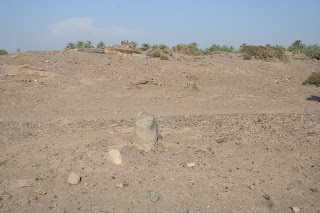 One thing it is almost impossible to do is to know about something that the tour guide doesn't know, especially in a country like Yemen. Well, I managed to do that with the help of the Bradt travel guide when I was there. There was a tiny paragraph hidden deep in the Tihana section labelled 'Midamman'. In terms of learning about it, it's not particularly helpful, but at least it helped us to find it. Our guide, Noman, was sceptical, but persisted in asking a few locals until we found one who knew of it. It says:
One thing it is almost impossible to do is to know about something that the tour guide doesn't know, especially in a country like Yemen. Well, I managed to do that with the help of the Bradt travel guide when I was there. There was a tiny paragraph hidden deep in the Tihana section labelled 'Midamman'. In terms of learning about it, it's not particularly helpful, but at least it helped us to find it. Our guide, Noman, was sceptical, but persisted in asking a few locals until we found one who knew of it. It says: "The small village of Midamman is located 21km from Zabid along the road to al-Fazah, a stretch of road covered with dense date palm trees. The village of Midamman is not noteworthy except for its connection to 'Yemen Henge', a series of Bronze-Age megaliths long known to the inhabitants of the region, and only recently found by Western archaeologists. The megaliths are a little hard to find -- they stand about 5km outside Midamman, reached by dirt roads heading toward the north."
"The small village of Midamman is located 21km from Zabid along the road to al-Fazah, a stretch of road covered with dense date palm trees. The village of Midamman is not noteworthy except for its connection to 'Yemen Henge', a series of Bronze-Age megaliths long known to the inhabitants of the region, and only recently found by Western archaeologists. The megaliths are a little hard to find -- they stand about 5km outside Midamman, reached by dirt roads heading toward the north." As you probably know if you have met me or my mother, you would know that stone circles and areas fascinate me. I have done research on stone circles in Morocco (Mzora #860) and visited others in far flung places such as Armenia (Zorats Karer Carahunge #910), the Orkneys (#987) and Colombia near Villa de Leyva (#986), and of course more familiar places like Stone Henge (#905).
As you probably know if you have met me or my mother, you would know that stone circles and areas fascinate me. I have done research on stone circles in Morocco (Mzora #860) and visited others in far flung places such as Armenia (Zorats Karer Carahunge #910), the Orkneys (#987) and Colombia near Villa de Leyva (#986), and of course more familiar places like Stone Henge (#905).Very close to the Red Sea, the basalt and granite rocks, which are around 3m in length (sadly, none still standing), and around 7 tons in weight are said to be from around 3500 B.C. which is significantly older than most other civilizations in the region. The rocks themselves are said to be from the Surat Mountains 60km away and had to be floated across the Red Sea on rafts.
The remains of a male skeleton and three children were found in charred earth near the stones and are thought to be connected to a ritual or commemoration.
 "Furthermore, there are many rock drawings in the desert areas adjacent to the Yemeni stone circle in which collectors, hunters, and herders of the period between the fifth and second millennia BC depicted themselves, their weapons, their customs, and their daily life. Hunting featured prominently in the life of these early groups of people. These people differed in appearance from later inhabitants of the region, so it is assumed that they were driven out of their settlements by the expansion of the southern Semitic tribes." http://nabataea.net/sarabia.html
"Furthermore, there are many rock drawings in the desert areas adjacent to the Yemeni stone circle in which collectors, hunters, and herders of the period between the fifth and second millennia BC depicted themselves, their weapons, their customs, and their daily life. Hunting featured prominently in the life of these early groups of people. These people differed in appearance from later inhabitants of the region, so it is assumed that they were driven out of their settlements by the expansion of the southern Semitic tribes." http://nabataea.net/sarabia.htmlhttp://www.abc.net.au/radionational/programs/scienceshow/the-henge-in-yemen/3567150 A tv show that aired discussing the discovery amongst archaeologists.
http://www.stonepages.com/news/archives/000110.html
http://www.oocities.org/athens/troy/4040/circles.htm -- others in Saudi Arabia




































0 nhận xét